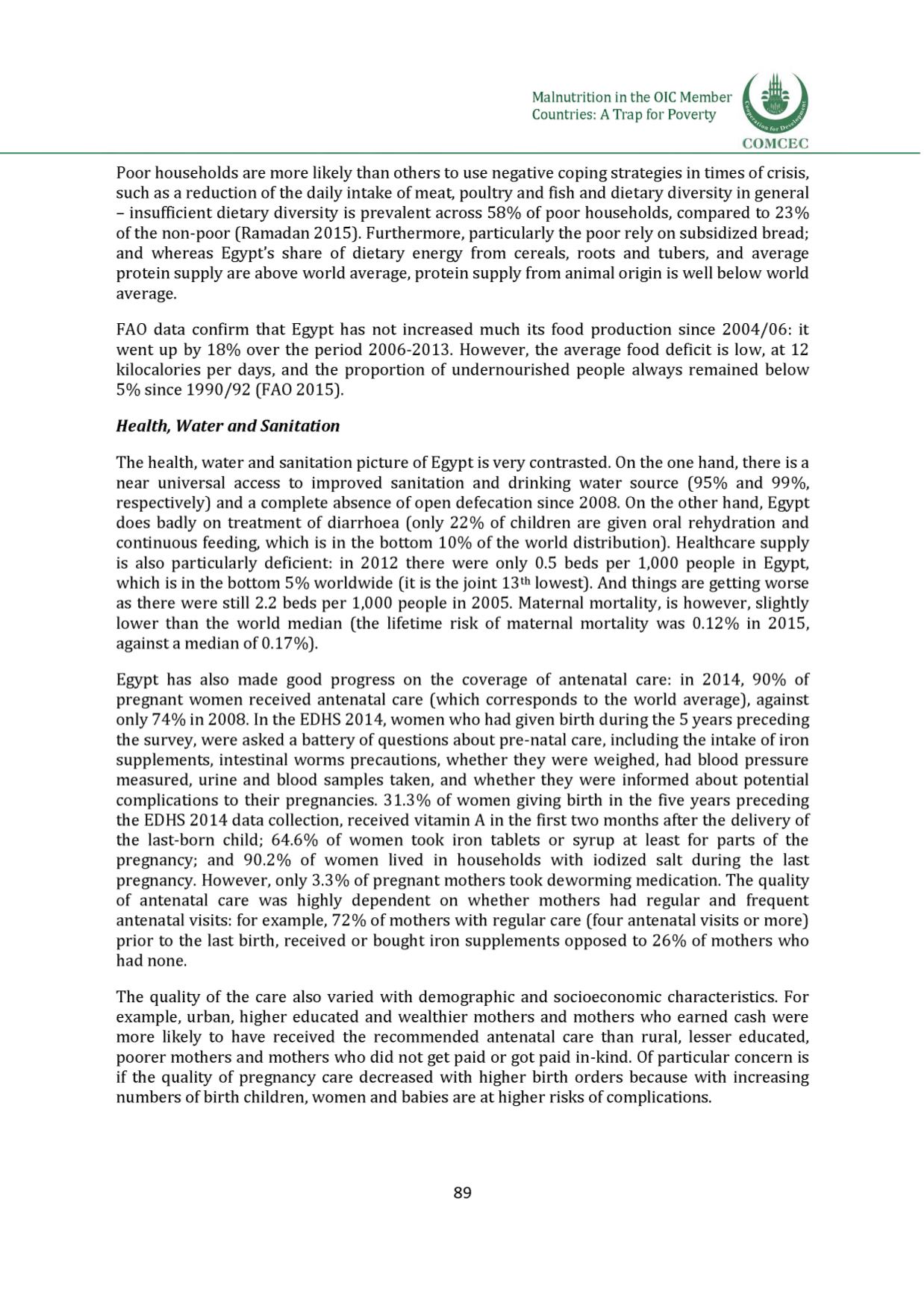

Malnutrition in the OIC Member
Countries: A Trap for Poverty
Poor households are more likely than others to use negative coping strategies in times of crisis,
such as a reduction of the daily intake of meat, poultry and fish and dietary diversity in general
- insufficient dietary diversity is prevalent across 58% of poor households, compared to 23%
of the non-poor (Ramadan 2015). Furthermore, particularly the poor rely on subsidized bread;
and whereas Egypt's share of dietary energy from cereals, roots and tubers, and average
protein supply are above world average, protein supply from animal origin is well below world
average.
FAO data confirm that Egypt has not increased much its food production since 2004/06: it
went up by 18% over the period 2006-2013. However, the average food deficit is low, at 12
kilocalories per days, and the proportion of undernourished people always remained below
5% since 1990/92 (FAO 2015).
Health, Water and Sanitation
The health, water and sanitation picture of Egypt is very contrasted. On the one hand, there is a
near universal access to improved sanitation and drinking water source (95% and 99%,
respectively) and a complete absence of open defecation since 2008. On the other hand, Egypt
does badly on treatment of diarrhoea (only
2 2
% of children are given oral rehydration and
continuous feeding, which is in the bottom 10% of the world distribution). Healthcare supply
is also particularly deficient: in 2012 there were only 0.5 beds per 1,000 people in Egypt,
which is in the bottom 5% worldwide (it is the joint 13thlowest). And things are getting worse
as there were still 2.2 beds per 1,000 people in 2005. Maternal mortality, is however, slightly
lower than the world median (the lifetime risk of maternal mortality was 0.12% in 2015,
against a median of 0.17%).
Egypt has also made good progress on the coverage of antenatal care: in 2014, 90% of
pregnant women received antenatal care (which corresponds to the world average), against
only 74% in 2008. In the EDHS 2014, women who had given birth during the 5 years preceding
the survey, were asked a battery of questions about pre-natal care, including the intake of iron
supplements, intestinal worms precautions, whether they were weighed, had blood pressure
measured, urine and blood samples taken, and whether they were informed about potential
complications to their pregnancies. 31.3% of women giving birth in the five years preceding
the EDHS 2014 data collection, received vitamin A in the first two months after the delivery of
the last-born child; 64.6% of women took iron tablets or syrup at least for parts of the
pregnancy; and 90.2% of women lived in households with iodized salt during the last
pregnancy. However, only 3.3% of pregnant mothers took deworming medication. The quality
of antenatal care was highly dependent on whether mothers had regular and frequent
antenatal visits: for example, 72% of mothers with regular care (four antenatal visits or more)
prior to the last birth, received or bought iron supplements opposed to 26% of mothers who
had none.
The quality of the care also varied with demographic and socioeconomic characteristics. For
example, urban, higher educated and wealthier mothers and mothers who earned cash were
more likely to have received the recommended antenatal care than rural, lesser educated,
poorer mothers and mothers who did not get paid or got paid in-kind. Of particular concern is
if the quality of pregnancy care decreased with higher birth orders because with increasing
numbers of birth children, women and babies are at higher risks of complications.
89
















